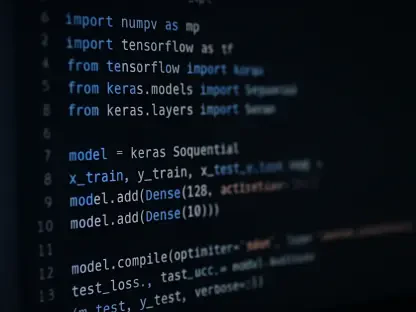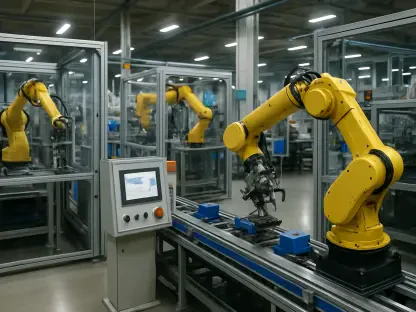Imagine a world where artificial intelligence can process complex tasks at lightning speed, yet remain accessible to organizations with limited resources, and this vision is becoming reality with Meituan’s groundbreaking contribution to the AI landscape. As a leading Chinese technology company, Meituan has unveiled a powerful large language model that promises to redefine efficiency and scalability in AI applications. Released on platforms like GitHub and Hugging Face, this model emerges as a beacon of innovation, targeting agentic tasks such as autonomous decision-making while maintaining cost-effectiveness. This review delves into the intricacies of this cutting-edge technology, exploring its standout features and its potential to reshape the global AI ecosystem.
Core Features and Technical Breakthroughs
Unpacking the Mixture-of-Experts Architecture
At the heart of this AI model lies a sophisticated Mixture-of-Experts (MoE) architecture, encompassing a staggering 560 billion parameters. What sets it apart is the selective activation of only 18.6 to 31.3 billion parameters per token, averaging around 27 billion. This strategic design ensures high performance without the hefty computational overhead often seen in comparable models, positioning it as a formidable competitor in the AI arena.
Beyond raw numbers, this architecture optimizes resource allocation, enabling the model to handle specialized tasks with remarkable precision. Compared to mainstream large language models, it achieves a delicate balance between power and efficiency. Such an approach not only enhances scalability but also broadens the scope of applications across diverse environments, from research labs to commercial deployments.
Performance-Enhancing Mechanisms
Diving deeper into its technical innovations, the model incorporates a ‘Zero-Computation Experts’ mechanism, which minimizes unnecessary processing to boost efficiency. Additionally, a PID controller stabilizes activation levels, ensuring consistent performance under varying workloads. Inter-layer cross-channel pathways further elevate its capabilities by facilitating seamless parallel processing, a critical factor in handling complex computations.
The results of these advancements are striking. Training was completed in a mere 30 days, a testament to the streamlined methodologies employed. On H800 GPUs, inference speeds reach up to 100 tokens per second, showcasing its prowess in real-time applications. These metrics highlight a significant leap forward in delivering rapid, reliable AI solutions.
Cost-Effectiveness as a Core Principle
A standout attribute of this model is its affordability, with an output cost of just 5 yuan per million tokens. This pricing structure makes it a viable option for a wide range of users, from independent developers to large enterprises. Such cost-efficiency aligns with Meituan’s mission to democratize AI, breaking down financial barriers that often hinder adoption.
This focus on accessibility ensures that cutting-edge technology is not confined to well-funded entities. By prioritizing low operational costs, Meituan enables broader experimentation and innovation within the global AI community. This strategic emphasis could serve as a model for other tech giants aiming to expand the reach of advanced tools.
Industry Trends and Strategic Alignment
Reflecting a Shift Toward Accessibility
The release of this AI model mirrors a broader trend in the tech industry toward efficiency and open access. Leading companies increasingly recognize the value of open-sourcing their innovations to accelerate collective progress. Meituan’s decision to share this technology freely reflects a commitment to reducing entry barriers, especially for those in resource-limited settings.
This movement is not merely altruistic; it fosters a collaborative environment where shared knowledge drives faster advancements. By contributing to this trend, Meituan positions itself as a catalyst for change, encouraging other organizations to follow suit. The ripple effects of such initiatives could transform how AI is developed and deployed worldwide.
Integration Into a Broader AI Vision
Meituan’s strategy extends beyond a single model, encompassing a multi-tiered approach to AI integration. This includes embedding intelligence into workplace tools, enhancing consumer products, and building foundational models like the one under review. Such a comprehensive framework underscores the company’s ambition to influence various sectors through technology.
Evidence of this vision is seen in prior initiatives like NoCode, a coding assistant, Kangaroo Advisor for business decisions, and Meituan Jibai for hotel management solutions. These projects illustrate a consistent effort to apply AI across industries, paving the way for the current model’s adoption in diverse real-world scenarios. This holistic perspective enhances the model’s relevance and potential impact.
Practical Applications and Potential
Empowering Agentic Task Solutions
One of the most promising aspects of this model is its focus on agentic tasks, where autonomous decision-making and problem-solving are paramount. This capability opens doors to applications in fields like automated customer service, logistics optimization, and even strategic planning. The model’s design caters specifically to scenarios requiring nuanced, independent action.
Such versatility makes it a valuable asset for businesses seeking to streamline operations through intelligent automation. Whether it’s managing complex workflows or responding to dynamic challenges, the technology offers a robust foundation for practical implementation. Its adaptability ensures relevance across a spectrum of use cases, from small-scale projects to enterprise-level systems.
Bridging Research and Commercial Needs
Beyond immediate applications, the model serves as a bridge between academic research and commercial deployment. Its open-source nature invites researchers to explore new methodologies, while its efficiency appeals to companies looking for cost-effective solutions. This dual appeal fosters a synergy that could accelerate innovation in both domains.
Meituan’s emphasis on custom evaluation datasets and multi-agent data trajectories during development further enhances its suitability for varied contexts. By addressing the needs of both theoretical exploration and practical utility, the model stands as a unifying force in the AI landscape, potentially influencing how future technologies are crafted.
Challenges and Areas for Improvement
Navigating Technical Complexities
Despite its impressive capabilities, maintaining consistent performance across diverse tasks remains a challenge for this model. Variations in data types and environmental factors can sometimes impact outcomes, necessitating ongoing refinement. Addressing these inconsistencies is crucial for ensuring reliability in all scenarios.
Moreover, the complexity of the MoE architecture, while innovative, may pose difficulties for users without advanced technical expertise. Simplifying integration processes or providing comprehensive support resources could mitigate this issue. Meituan’s continued focus on usability will be key to broadening the model’s reach.
Scalability and Regulatory Hurdles
As adoption grows, scalability concerns may arise, particularly when deploying the model in large-scale or global contexts. Ensuring that infrastructure can support widespread use without compromising speed or efficiency is a critical consideration. This aspect demands strategic planning to prevent bottlenecks.
Additionally, regulatory constraints in different regions could affect deployment timelines and methods. Navigating compliance with data privacy and AI governance laws will require proactive measures. Meituan’s efforts in hyperparameter transfer and stability strategies during development signal a commitment to overcoming such obstacles, though sustained attention is necessary.
Reflecting on a Milestone in AI Development
Looking back, the unveiling of this AI model by Meituan marked a pivotal moment in the journey toward accessible, high-performance artificial intelligence. Its blend of innovative architecture, rapid processing, and affordability set a new benchmark for what large language models could achieve. The impact resonated across both research communities and industry sectors, highlighting a path forward for inclusive technological progress.
Moving ahead, stakeholders should consider investing in complementary tools and training programs to maximize the model’s potential. Collaborative efforts to refine its capabilities, particularly in addressing scalability and regulatory challenges, prove essential. By building on this foundation, the tech community could ensure that such advancements continue to drive meaningful change in how AI is applied and understood globally.









